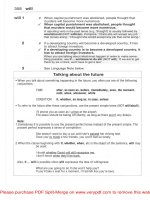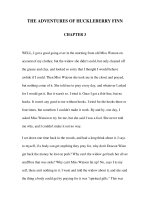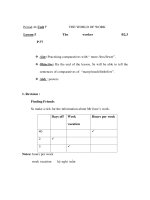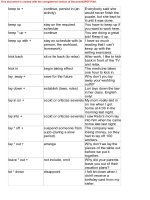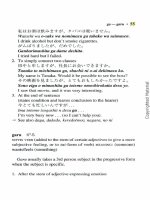Hydrodynamics of ship propellers; series 3
Bạn đang xem bản rút gọn của tài liệu. Xem và tải ngay bản đầy đủ của tài liệu tại đây (11.3 MB, 292 trang )
Cambridge
Ocean Technology
Series
1. Faltinsen: Sea Loads on Ships and Offshore Structures
2. Burcher & Rydil1: Concepts in Submarine Design
3. Breslin & Andersen: Hydrodynamics of Ship Propellers
John P. Breslin
Professor Emeritus, Department
Stevens Institute of Technology
of Ocean Engineering,
and
Poul Andersen
Department of Ocean Engineering,
The Technical University of Denmark
PUBUSHED BY THE PRESS SYNDICATE OF THE UNIVERSITY OF CAMBRIDGE
Contents
The Pin Building, Trumpingron Street, Cambridge CB2 1RP, United Kingdom
CAMBRIDGE UNIVERSITY PRESS
The Edinburgh Building, Cambridge CB2 2RU, United Kingdom
40 West 20th Street, New York, NY 10011-4211, USA
10 Stamford Road, Oakleigh, Melbourne 3166, Australia
© Cambridge University Press 1994
This book is in copyright. Subject to stamtory exception
and to the provisions of relevant collective licensing agreements,
no reproduction of any part may take place without the
wrinen permission of Cambridge University Press
First published 1994
Reprinted 1996
First paperback edition 1996
Preface
Notation
Abbreviations
xi
xiv
xxiv
1
Brief review of basic hydrodynamic theory
Continuity
Equations of motion
Velocity fields induced by basic singularities
Vorticity
1
1
2
7
17
Library of Congress Cataloguing in Publication data
2
Breslin, John P.
Hydrodynamics of ship propellers I John P. Breslin, Poul Andersen.
p. cm. - (Cambridge ocean technology series; 3)
Includes bibliographical references and index.
1. Propellers. 2. Ships-Hydrodynamics.
1. Andersen, Poul,
1951- . II. Tide. III. Series.
VM753.B6S
1993
623.S·73-dc20
93-26511
CIP
Properties of distributions of singularities
Planar distributions in two dimensions
Non-planar and planar distributions in three dimensions
26
26
33
3
Kinematic boundary conditions
42
4
Steady flows about thin, symmetrical sections in two dimensions
The ogival section
The elliptical section
Generalization to approximate formulae for families of
two-dimensional hydrofoils
A brief look at three-dimensional effects
46
51
54
57
62
Pressure distributions and lift on flat and cambered sections at
small angles of attack
The flat plate
Cambered sections
66
66
74
Printed in the United Kingdom at the University Press, Cambridge
A catalogue record for this book is available from the British Library
ISBN 0521413605
hardback
ISBN 0 521 574706 paperback
5
6
Design of hydrofoil sections
Application of linearized theory
Application of non-linear theory
7
Real fluid effects and comparisons of theoretically and
experimentally determined characteristics
Phenomenological aspects of viscous flows
Experimental characteristics of wing sections and comparisons
with theory
86
87
103
111
111
117
vii
viii
Contents
Contents
8
9
Cavitation
Historical overview
Prediction of cavitation inception
Cavitating sections
Partially cavitating hydrofoils
Modification of linear theory
Supercavitating sections
Unsteady cavitation
Actuator disc theory
Heavily loaded disc
Lightly loaded disc
128
128
130
140
142
151
156
159
162
166
187
ix
18 Lifting-fiurface theory
334
334
337
340
368
Overview of extant unsteady theory
Blade geometry and normals
Linear theory
A potential-based boundary-€lement procedure
19 Correlations of theories with measurements
374
20 Outline of theory of intermittently
387
cavitating propellers
A basic aspect of the pressure field generated by unsteady
cavitation
Pressure field due to cavitating propeller
Numerical solution of the intermittently-(;avitating
propeller
problem
Comparison of calculated and observed transient blade
cavitation and pressures
10 Wing theory
196
11 Lifting-line representation
207
209
219
222
21 Forces on simple bodies generated by intermittent
224
22 Pressures on hulls of arbitrary shape generated by blade loading,
of propellers
Induced velocities from vortex elements
Generalization to a continuous radial variation of circulation
Induction factors
Forces acting on the blades and the equation for the circulation
density
12 Propeller design via computer and practical considerations
Criteria for optimum distributions of circulation
Optimum diameter and blade-area-ratio determinations
Calculation procedures
Pragmatic considerations
13 Bull-wake characteristics
Analysis of the spatial variation of hull wakes
Temporal wake variations
227
227
235
239
252
262
264
270
14 Pressure fields generated by blade loading and thickness in
uniform flows; comparisons with measurements
Pressure relative to fixed axes
Comparisons with measurements
272
272
281
15 Pressure fields generated by blade loadings in hull wakes
290
16 Vibratory forces on simple surfaces
301
17 Unsteady forces on two-dimensional
sections and hydrofoils of
finite span in gusts
Two-dimensional sections
Unsteady lift on hydrofoils of finite span
Implications for propellers
315
315
327
332
cavitation
Hull forces without solving the diffraction problem
thickness and intermittent cavitation
Representation of hulls of arbitrary shape in the presence of a
propeller and water surface
Correlation of theory and measurements
Correlations of theory and measurements for non-(;avitating
conditions
Summary and conclusion
23 Propulsor configurations for increased efficiency
A procedure for optimum design of propulsor configurations
Optimized loadings on compound propulsor configurations
Flow-(;onditioning devices
Summary and conclusion
Appendices
A Inversion of the airfoil integral equations
B The Kutta-Joukowsky theorem
C The mean value of the radial velocity component induced by
a helical vortex at downstream infinity
D Conservation of circulation
E Method of characteristics
F Boundary conditions imposed by water surface at high and
low frequencies
388
393
403
404
411
418
425
425
435
451
451
454
456
462
477
482
484
484
490
494
496
498
500
x
Contents
Mathematical compendium
1 Taylor expansion
2 Dirac's t5--function
3 Green's identities and Green function
4 Evaluation of integrals with Cauchy- and Hadamard-type
singular-kernel functions
5 Fourier expansions of 1/R
6 Properties of the Legendre function QnJ
7 Outline of calculus of variations
8 Table of airfoil integrals
507
513
518
522
523
References
527
A uthors cited
547
Sources of figures
550
Index
551
2
503
503
504
505
Preface
This book reflects the work of a great number of researchers as well as
our own experience from research and teaching of hydrodynamics and
ship-propeller theory over a combined span of more than 60 years. Its
development began in 1983-84 during the senior author's tenure as visiting
professor in the Department of Ocean Engineering, The Technical University of Denmark, by invitation from Professor Sv. Aa. Harvald. During
this sabbatical year he taught a course based on his knowledge of propeller theory garnered over many years as a researcher at Davidson Laboratory and professor at Stevens Institute of Technology. Written lecture
notes were required, so we were soon heavily engaged in collecting material and writing a serial story of propeller hydrodynamics with weekly publications. As that large audience consisted of relatively few masters and
doctoral students but many experienced naval architects, it was necessary
to show mathematical developments in greater detail and, in addition, to
display correlations between theory and practical results.
Encouraged by Professor P. Terndrup Pedersen, Department of Ocean
Engineering, The Technical University of Denmark, we afterwards started
expanding, modifying and improving the notes into what has now become
this book. In the spirit of the original lecture notes it has been written
primarily for two groups of readers, viz. students of naval architecture
and ship and propeller hydrodynamics, at late undergraduate and graduate levels, and practicing naval architects dealing with advanced propulsion problems. It is our goal that such readers, upon completion of the
book, will be able to understand the physical problems of ship-propeller
hydrodynamics, comprehend the mathematics used, read past and current
literature, interpret calculation and experimental findings and correlate
theory with their own practical experiences.
To make reading as easy as possible the mathematical concepts and derivations which might have caused trouble for those readers of a more practical background have been explained and executed in far greater detail
than found in the literature. Physical interpretations are given throughout
together with explanations of the procedures and results in engineering
terms and with simple solutions of practical utility wherever possible. We
xi
xii
Preface
hope that the book in this form will be equally suitable as a text in university courses, a guide for self-tuition and a reference book in ship-design
offices.
The subject matter is broadly divided into two parts. In the first, basic
hydrodynamics is outlined with comprehensive applications to the construction of practical representations of the steady performance of hydrofoils, with and without cavitation, wings and propellers. Here lifting-line
theory is described, including propeller design and analysis via computer
and pragmatic considerations from actual performance. The last part addresses the unsteady forces on propellers in wakes via lifting-surface
theory as well as propeller-induced vibratory forces on simple, nearby
boundaries and upon ship hulls. Both non-eavitating and cavitating propellers are treated. In the final chapter a rational procedure for the optimization of compound propulsors for increased efficiency is described.
Throughout the book, in addition to the theoretical developments, the
results of calculations are correlated with experimental findings. Remarks
and developments that the reader may wish to skip in his first reading are
set in small print. No exercises are provided; to achieve proficiency, the
reader, after initial study of the text, should derive the results independently.
An immense pleasure, when writing this book, has been to experience
the interest and help from colleagues, institutions and companies all over
the world. They generously spent their time answering our questions and
supplied us with material, including photographs and figures, with permission to reproduce them in the text. These sources are acknowledged in the
figure captions. We are very grateful for this assistance without which
this book would have been much more incomplete and less useful. We are
particular indebted to Dr. W. van Gent, Maritime Research Institute
Netherlands; Professor M. D. Greenberg, University of Delaware; Mr. C.A. Johnsson, SSPA Maritime Consulting AB; Professor J. E. Kerwin and
Dr. S. A. Kinnas, Massachusetts Institute of Technology. Our sincere
thanks are also due to Mr. J. H. McCarthy, David Taylor Research
Center; Dr. K. Meyne, Ostermann Metallwerke; Dr. W. B. Morgan, David
Taylor Research Center; Mr. P. Bak Olesen, A.P. M011er;and Mr. H.
Vagi, Mitsui Engineering and Shipbuilding Co., Ltd. for help and suppoit
and to Professor R. Eatock Taylor, Oxford University, for his effective
proposal of our manuscript to Cambridge University Press. We also wish
to express our gratitude to present and former colleagues at the Department of Ocean Engineering, The Technical University of Denmark. They
include Professor Emeritus Sv. Aa. Harvald and Professor P. Terndrup
Pedersen who initiated vital parts of the entire process and later together
with Professor J. Juncher Jensen, Head of Department, gave us encour-
Preface
'xiii
agement and support. Invaluable help was provided by the Staff; Ms. L.
Flicker typed the lecture-notes version of the manuscript and later versions were typed by Ms. V. Jensen.
We acknowledge the financial support of F. L. Smidth & Co. A/S who,
on the occasion of their lOOth-year anniversary, sponsored the first author's stay as visiting professor. Later support was provided by The Danish Technical Research Council under their Marine Design Programme.
Lyngby, Denmark
October 1992
John P. Breslin
Poul Andersen
~n
Notation
The following list of symbols is provided partly as an aid to the reader
who wants to use this text as a reference book and read selected chapters.
The list contains mainly globally used symbols while many other symbols,
including those distinguished by subscript, are defined locally. The notation is not entirely consistent, symbols being used with different definitions, however, rarely in the same sections. Practical usage has been given
priority. For this reason ITTC notation has only been partly used.
The coordinate systems are as follows: For two-dimensional flows the xaxis is horizontal, generally displayed in figures as pointing to the right,
with the y-axis vertical and positive upwards. Incoming flow is along the
x-axis but opposite in direction. For three-dimensional flows the x-axis is
horizontal, with a few exceptions coinciding with the propeller axis and
generally displayed in figures as pointing to the right. The y-axis is also
horizontal, pointing to port and the z-axis is vertical, pointing upwards.
As in the two-dimensional case the incoming flow is along the x-axis but
opposite in direction. Moreover, a cylindrical system is used. Its x-axis
coincides with that of the cartesian system while the angle is measured
from the vertical (z-axis), positive in the direction of rotation of a righthanded propeller.
For the two-dimensional case this orientation of axes is in contrast to
that used by aerodynamicists (who take the incoming flow along the positive x-axis). However, it is consistent with the three-dimensional definition as well as with the long tradition in naval architecture that the ship
is viewed from starboard and the bow consequently is to the right hand.
~
xvi
Notation
Notation
xvii
xviii
Notation
Notation
xix
xviii
Notation
Notatwn
,un
xx
Notation
Notation
xxi
xxii
Notation
Notation
xxiii
Abbreviations
ATTC
CETENA
DTMB
DTRC
HSVA
INA
ITTC
L.E.
MARIN
MIT
NACA
NASA
NPL
PUF
RINA
SNAME
SSPA
T .E.
TMB
VWS
American Towing Tank Conference
Centro per gli Studi di Tecnica Navale
David Taylor Model Basin
- later DTRC
David Taylor Research Center
Hamburgische Schiffbau-Versuchsanstalt
Institution of Naval Architects
- later RINA
International Towing Tank Conference
leading edge
Maritime Research Institute Netherlands
Massachusetts Institute of Technology
National Advisory Committee for Aeronautics
-later NASA
National Air and Space Administration
National Physical Laboratory
Propeller Unsteady Force (MIT computer program)
The Royal Institution of Naval Architects
The Society of Naval Architects and Marine Engineers
SSPA Maritime Consulting AB
- (SSPA: Statens Skeppsprovningsanstalt)
trailing edge
Taylor Model Basin
- later DTRC
Versuchsanstalt fUr Wasserbau und Schiffbau
1
Brief Review of Basic Hydrodynamic Theory
An extensive, highly mathematical literature exists dealing with fluidmechanical aspects of ship propellers.
Invariably, the mathematical developments are only outlined, impeding
easy comprehension even by knowledgeable readers. Our aim is to elucidate the mathematical theory in much greater detail than is generally
available in extant papers. In this context, the first three chapters are
provided as aids for those who have not had extensive practice in the application of classical hydrodynamical theory to flows induced in fluids by
the motions of bodies. The fluid of interest is water which is taken to be
incompressible and inviscid. Modifications arising from viscosity are described in a later chapter (Chapter 7) through reference to experimental
observations.
This review begins with the derivation of the concept of continuity or
conservation of mass at all points in sourceless flow and proceeds to the
development of the Euler equations of motion. In the restricted but
important class of irrotational motions (zero vorticity) Laplace's equation
for the velocity potential is obtained. The remainder of this chapter is
devoted to derivations of fundamental solutions of Laplace's equation in
two and three dimensions.
It is emphasized that these first two chapters are necessarily limited in
scope, being directed to our needs in subsequent chapters. There are many
excellent books which should be consulted for those seeking greater depth
and broader description of hydrodynamic theory. Among these we suggest
Batchelor (1967), Lamb (1963), Lighthill (1986), Milne-Thomson (1955),
and Yih (1988), and Newman (1977) for modern applications.
CONTINUITY
Consider a general, three-dimensional flow field whose vector velocity is
defined by
q
= iu(x,y,z,t) + jv(x,y,z,t) + kw(x,y,z,t)
for an incompressible fluid.
xxiv
(Ll)
2
Brief Review of Basic Hydrodynamic
Theory
Equations of Motion
3
Equations of Motion
6
Brief Review of Basic Hydrodynamic
Theory
Velocity Fields Induced by Basic Singularities
7
8
Brief Review of Basic Hydrodynamic
Theory
Velocity Fields Induced by Basic Singularities
9
10
Brief Review of Basic Hydrodynamic
Theory
Velocity Fields Induced by Basic Singularities
11
12
Brief Review of Basic Hydrodynamic
Theory
Velocity Fields Induced by Basic Singularities
13
14
Brief Review of Basic Hydrodynamic
Theory
Velocity Fields Induced by Basic Singularities
15
16
Brief Review of Basic Hydrodynamic
Theory
Vorticity
18
Brief Review of Basic Hydrodynamic
Theory
Vorticity
19
20
Brief Review of Basic Hydrodynamic
Theory
Vorticity
21
22
Brief Review of Basic Hydrodynamic
Theory
Vorticity
23
24
Brief Review of Basic Hydrodynamic
Theory
Vorticity
25
Planar Distributions
2
Properties of Distributions of Singularities
In this chapter we determine the basic behavior of the velocity fields of
the various singular solutions of Laplace's equation when they are distributed or "smeared" along lines and surfaces of finite extent. Their
properties are particularly important on the lines and surfaces as they will
be repeatedly used to generate approximate flow envelopes about thin
hydrofoil sections in two dimensions and about slender bodies and lifting
surfaces in three space dimensions.
PLANAR DISTRIBUTIONS IN TWO DIMENSIONS
Source Distributions
Source distributions are useful in generating section shapes symmetrical
about the long axis. It is therefore important to understand the connection between the source density and the velocity components induced by
the entire distribution of sources.
From the foregoing, the potential of a line of sources in two dimensions
is from (1.35)
in Two Dimensions
27
